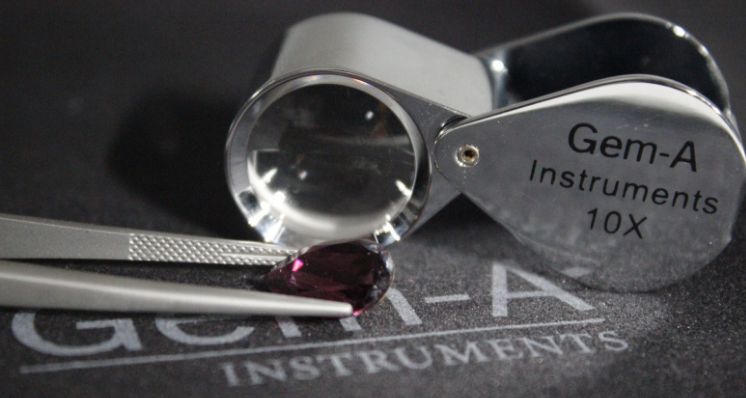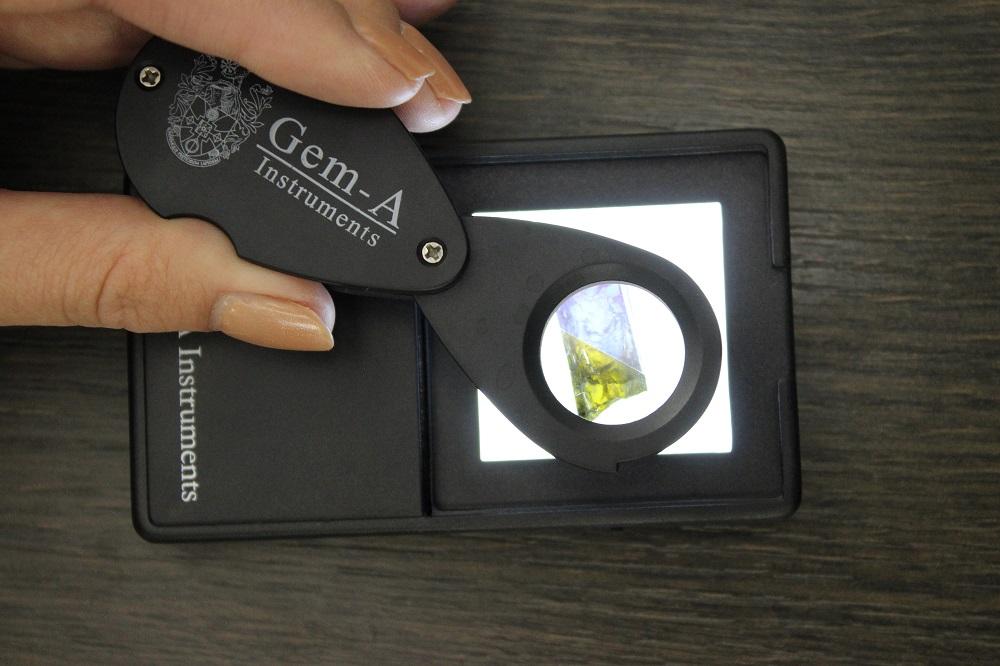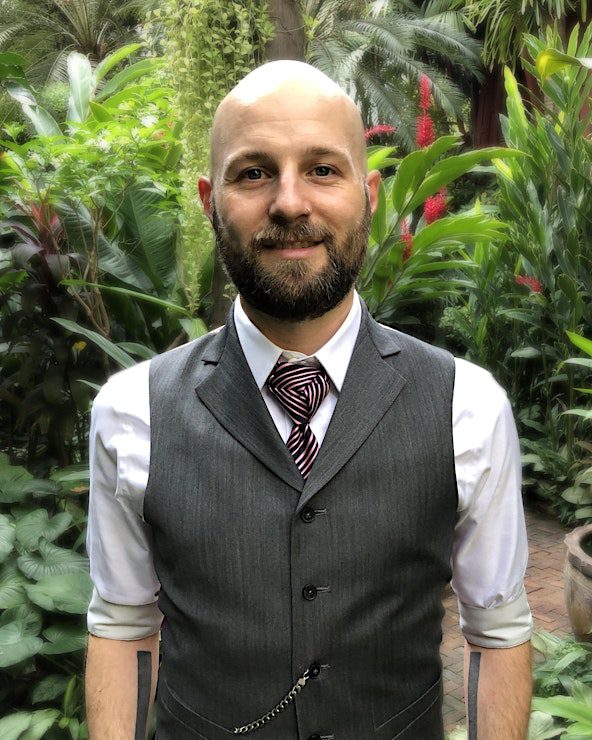Gem-A Instruments manager, Sam Lloyd FGA DGA EG shares her advice on compiling your own gemmology toolkit that’s useful, portable and reliable in the field or at trade events. How many of Sam’s essential items are in your collection? Find out here…
For me, the essentials of any gemmology toolkit start with the hand-held instruments. These smaller items are portable and often come with their own storage, which means they travel well in a backpack or suitcase.
A Reliable 10x Loupe
We all know the importance of a loupe but there are some things to consider. You should ideally look for a loupe that is described as having an achromatic and aplanatic lens. Aplanatic means that the view is distortion free; even at the edges of your loupe there should be no blurring or bending of the image. With an aplanatic lens, if you were to place your loupe over gridded paper, the lines would be intact and straight when viewed.
Achromatic refers to colour. A good achromatic loupe will not lose quality of colour in any areas and will show no colour fringes, which may deceptive when looking at a gemstone, towards the edges.
A Polariscope
My advice would be to choose a portable folding polariscope so that you can quickly tidy it away and move on. A polariscope is important for the testing of transparent and some translucent gemstones, whether they are in the rough, fashioned into jewellery items, or carved into beads and small objects.
A quick polariscope test will confirm whether your material is singly or doubly refractive, (isotropic or anisotropic) differentiating things like spinel and sapphire instantly with such ease. It’s always my first test as it rules out many options quickly.
A Spectroscope
The more instruments we have, often the better, because tests can back-up other tests. An ideal gemmology toolkit gives the owner/user the ability to not just test a stone, but also conduct a second or possibly a third test to confirm these findings. In some circumstances we can test material with 10 or more tests and still be unsure! In others, we have a diagnostic answer from a single test… this is one of the things that makes gemmology such a specialist field.
Spectroscopes can be pretty diagnostic, portable and inexpensive, which is why I have added this to my ‘essentials’ list. A handheld spectroscope allows you to view the absorption spectra of gemstones and, as each one can vary significantly, they can be diagnostic. For example, an absorption band at 653nm is conclusive for zircon and often very quick and easy to see. When out and about I take my Gem-A diffraction grating spectroscope but do keep a prism to hand as well. You can see the differences in spectroscopes via Gem-A Instruments, here.
Good Lighting
Your kit should contain both incandescent and diffused light. A MagLite Compact Solitaire Incandescent Torch, for example, is lightweight and ideal for basic gemmological tests, such as observing colour change, analysing spectra and using colour filters. Next, you will want a portable LED flat light. This is useful for the inspection of rough and cut gemstones and can be used in conjunction with your loupe, a folding polariscope or a dichroscope.
What to Choose Next?
That’s easy! A refractometer with a really full reference set of RIs. With that you can identify anything that has a flat polished surface within minutes by establishing its refractive index. Having the core or ‘main’ gemstones on this list is great, but if you come across something more unusual you could miss it if you only have a very select range of constants. I like the new Sisk Reference Guide for information on all stones, from simple quartz to the rare and unusual.
What About Diamond Testers?
The Presidium Diamond Multi-Tester is quick to use and takes very little training or expertise. It separates diamonds, synthetic moissanites and other simulants. Elsewhere, the Gem-A Thermal Diamond Tester can separate diamonds and moissanites from other simulants, meaning you will need to use your loupe to distinguish moissanite from diamonds as a second stage.
For the individual who is just building their toolkit, these pieces of electronic equipment need not be on the top priority list. However, as your collection grows and your experience expands, they are certainly useful, quick and easy devices to add to your arsenal and make your professional life easier!
If you would like to invest in a gemmology toolkit, don’t worry, we have done the hard work for you! Check out this Gem-A Portable Gem Instruments Kit that contains the following; 10x chrome loupe, stainless steel tweezers, diffraction grating spectroscope, Chelsea Colour Filter, MagLite incandescent torch, portable LED lamp, folding polariscope, conoscope, London dichroscope and a handing zip case to store it all in. It is priced at RRP £284.40.
Did you know? Gem-A Instruments is Online
Gem-A Instruments has a brand new website that is available to browse now. The website is designed to provide a user friendly experience with full product details, high resolution images and shortcut links to recommended items. This is all available at the click of a button from the home page where instruments are organised into product type, such as Microscopes & Accessories, Light Sources & Torches and Loupes & Magnification.
You can access the website now using this link: shop.gem-a.com. The website is transactional for UK deliveries only at this time. In the meantime, if you would like to place an order for deliveries outside of the UK, use a discount code, or need any further information or advice, please call 0207 404 3334 or email instruments@gem-a.com.
Indulge your passion for gemstones with short courses and workshops from Gem-A.
To start your journey towards becoming a qualified gemmologist, take a look at the Gem-A Foundation course, here.
Cover image: A Gem-A Instruments 10x Loupe. Photograph by Henry Mesa.




